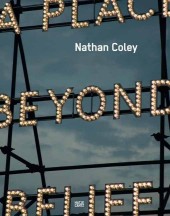 Neuerscheinungen 2014Stand: 2020-02-01 |
Schnellsuche
ISBN/Stichwort/Autor
|
Herderstraße 10
10625 Berlin
Tel.: 030 315 714 16
Fax 030 315 714 14
info@buchspektrum.de |

Nathan Coley, Brian Dillon, Tom Hunt, Lisa Le Feuvre
(Beteiligte)
Nathan Coley
Text v. Lisa Le Feuvre; Dillon, Brian; Hunt, Tom u.a.
2014. 144 S. w. 89 ill. 280 mm
Verlag/Jahr: HATJE CANTZ VERLAG 2014
ISBN: 3-7757-3675-1 (3775736751)
Neue ISBN: 978-3-7757-3675-6 (9783775736756)
Preis und Lieferzeit: Bitte klicken
Arbeiten des Künstlers aus dem letzten Jahrzehnt
Nathan Coley ( 1967 in Glasgow) interessiert sich für den öffentlichen Raum und beleuchtet in seiner künstlerischen Arbeit, auf welche Weise Architektur mit Bedeutung aufgeladen wird. Er untersucht dabei in unterschiedlichen Medien, was die gebaute Umgebung über die in ihr lebenden Menschen aussagt und auf welche Weise die Reaktionen der Gesellschaft und des Einzelnen auf sie kulturell konditioniert sind. Dabei ist das Readymade für Coley ein Mittel, um der Welt Bedeutung zu entnehmen und sie ihr dann erneut zuzuführen. Er beschäftigt sich mit den ritualisierten Formen, in denen wir unsere Überzeugungen ausdrücken, seien es Demonstrationstransparente, Hinweisschilder oder religiöse Rückzugsorte. Seine Arbeiten wandeln dabei häufig das Besondere ins Allgemeine, etwa wenn er in Leuchtbuchstaben die Erinnerungen eines New Yorkers an 9/11 zitiert oder die Namen der Toten von ihren Grabsteinen tilgt. Coleys Werke stellen die Frage, ob sie als repräsentative Darstellung Geltung haben, ob sie für den Betrachter "sprechen".
Nathan Coley ( 1967 in Glasgow) is interested in the idea of public space, and his practice explores the ways in which architecture becomes investedand reinvestedwith meaning. Across a range of media Coley investigates what the built environment reveals about the people it surrounds and how the social and individual response to it is in turn culturally conditioned. Using the readymade as a means to take from and re-place in the world, Coley addresses the ritual forms we use to articulate our beliefsfrom hand-held placards and erected signs to religious sanctuaries. Whether highlighting in illuminated letters the testimony of a New Yorker recalling the World Trade Center attacks or erasing the names of the dead from their gravestones, his work frequently turns the specific into the general, thereby testing its function as a form of social representation; simply, does this aphorism, this gravestone, this building, speak on my behalf?


